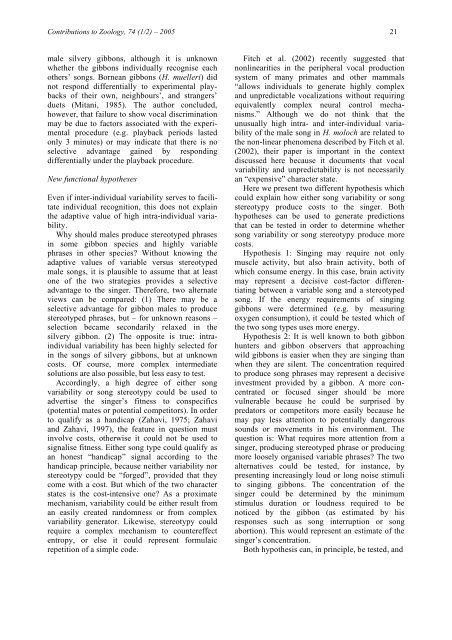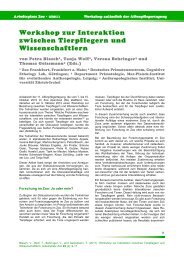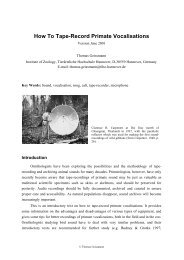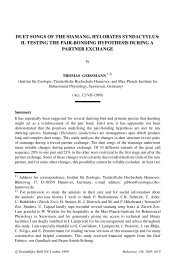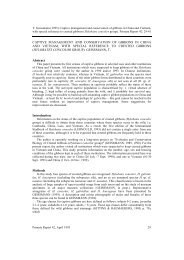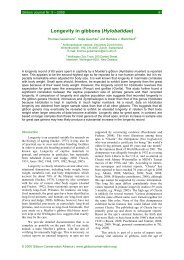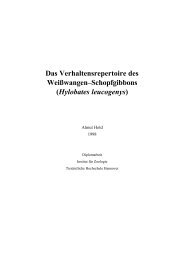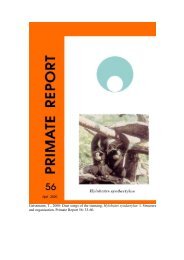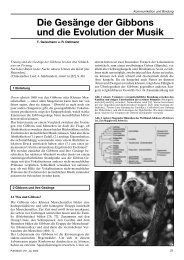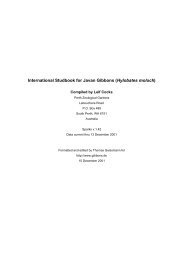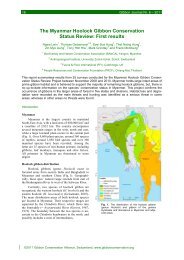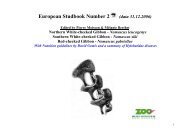20 T. Geissmann et al. – <strong>The</strong> Male Song <strong>of</strong> <strong>the</strong> <strong>Javan</strong> Silvery Gibbonsuggested for <strong>gibbon</strong> <strong>song</strong>s. <strong>The</strong> most commonlyproposed functions include defence <strong>of</strong> resources(territories, mates), mate attraction, and streng<strong>the</strong>ningand advertisement <strong>of</strong> pair bonds (Geissmann,1993, 1995, 1999, 2000; Geissmann and Orgeldinger,2000; Haim<strong>of</strong>f, 1984; Leighton, 1987).If <strong>the</strong> <strong>song</strong> served to streng<strong>the</strong>n and/or advertise<strong>the</strong> pair bond, mated pairs should engage in duetsinging. This is not <strong>the</strong> case in H. <strong>moloch</strong>(Kappeler, 1984 a, Geissmann and Nijman, 2001).Instead, <strong>the</strong> study <strong>male</strong>s appeared to abort <strong>the</strong>ir<strong>song</strong> bouts each time when a fe<strong>male</strong> started tosing. This occurred not only in three <strong>of</strong> <strong>the</strong> <strong>song</strong>bouts that were analysed for this study, but also inat least three o<strong>the</strong>r <strong>male</strong> <strong>song</strong> bouts <strong>of</strong> captive<strong>silvery</strong> <strong>gibbon</strong>s and in one <strong>male</strong> <strong>song</strong> monitored inCentral Java (Geissmann, unpublished observations).Although <strong>male</strong> <strong>silvery</strong> <strong>gibbon</strong>s may occasionallycall toge<strong>the</strong>r with fe<strong>male</strong>s in “screambouts” (Geissmann and Nijman, 2001) or “borderconflict call bouts” (Kappeler, 1984 a), <strong>the</strong>se callshave a different organisation and are notrecognised as <strong>song</strong> bouts.Traditionally, territorial defence is cited as one<strong>of</strong> <strong>the</strong> main functions <strong>of</strong> <strong>male</strong> <strong>gibbon</strong> <strong>song</strong>s, buto<strong>the</strong>r functions have been proposed, such as mateattraction, singing in order to defend mate and <strong>of</strong>fspringagainst o<strong>the</strong>r <strong>male</strong>s, and mediating spacingamong individuals (Cowlishaw, 1992; Geissmann,2000; Mitani, 1992). <strong>The</strong>se functions would requiremore frequent vocal activity from <strong>male</strong>sthan what we find in H. <strong>moloch</strong>. Males <strong>of</strong>H. <strong>moloch</strong> roughly sing about once a week (Geissmannand Nijman, 2001), which is much less thano<strong>the</strong>r <strong>gibbon</strong>s. For <strong>male</strong>s <strong>of</strong> o<strong>the</strong>r <strong>gibbon</strong> specieswhich do sing several times each week, nosignificant relationship was found between <strong>the</strong> frequencies<strong>of</strong> <strong>male</strong> solo <strong>song</strong> bouts and territorialconflicts; yet, <strong>the</strong>se <strong>male</strong>s are territorial and doprovide physical defence <strong>of</strong> <strong>the</strong>ir territories. Incontrast, territorial conflicts appear to correlatewith <strong>the</strong> frequency <strong>of</strong> <strong>song</strong> bouts <strong>of</strong> mated fe<strong>male</strong>s(Cowlishaw, 1992).Cowlishaw (1996) suggested that <strong>gibbon</strong> <strong>male</strong>s(but not fe<strong>male</strong>s) use assessment signals toadvertise resource-holding potential. Whitten(1984a, b) suggested that <strong>male</strong> <strong>song</strong>s <strong>of</strong> H. klossii(but not fe<strong>male</strong> <strong>song</strong>s) follow <strong>the</strong> handicap principle(e.g. Zahavi, 1975; Zahavi and Zahavi,1998) by requiring a lot <strong>of</strong> energy and stamina <strong>of</strong><strong>the</strong> singer. <strong>The</strong> <strong>song</strong>s would <strong>the</strong>n be an honestsignal declaring <strong>the</strong> singer’s fitness and his con-fidence and willingness to defend his territory.This hypo<strong>the</strong>sis is supported by <strong>the</strong> observationthat <strong>male</strong> Kloss’s <strong>gibbon</strong>s tend to maximise <strong>the</strong>irvocal output by singing about twice as <strong>of</strong>ten asfe<strong>male</strong>s (about once every 1.7-2.5 days) and byspending over seven times as much time singingas fe<strong>male</strong>s. In addition, <strong>male</strong>s sing earlier in <strong>the</strong>morning than fe<strong>male</strong>s. <strong>The</strong>y produce most <strong>of</strong> <strong>the</strong>ir<strong>song</strong>s before dawn (Tenaza, 1976; Whitten,1984b), at a time when most diurnal mammals tryto reduce <strong>the</strong>ir energy expenditure.In H. klossii and o<strong>the</strong>r members <strong>of</strong> <strong>the</strong> genus<strong>Hylobates</strong>, <strong>male</strong> solo <strong>song</strong>s have a longer durationand tend to occur earlier in <strong>the</strong> morning thanfe<strong>male</strong> or duet <strong>song</strong>s (Geissmann, 2000). <strong>The</strong>seobservations partially apply to H. <strong>moloch</strong>, as well.Whereas an average fe<strong>male</strong> solo <strong>song</strong> bout <strong>of</strong>H. <strong>moloch</strong> has a duration <strong>of</strong> about 7 minutes(Geissmann and Nijman, 2001), <strong>the</strong> six complete<strong>male</strong> solo <strong>song</strong> bouts we analysed had an averageduration <strong>of</strong> 23 minutes. This average does noteven include <strong>the</strong> longest recording <strong>of</strong> our study(40 min 45 s), because that <strong>song</strong> bout was notcompletely recorded. Recent field observations inCentral Java also document that most <strong>male</strong> <strong>song</strong>sstart before dawn when it is still dark, whereasmost fe<strong>male</strong> <strong>song</strong>s start after dawn (Geissmannand Nijman, 2001).<strong>The</strong> analogy to <strong>the</strong> Kloss’s <strong>gibbon</strong> does notextend, however, to <strong>the</strong> frequency <strong>of</strong> <strong>male</strong> singing.<strong>The</strong> field observations in Central Java (Geissmannand Nijman, 2001), as well as our observations inHowletts, suggest that <strong>male</strong>s sing only about onceper week, whereas fe<strong>male</strong>s sing about ten times as<strong>of</strong>ten. This appears to be a reversal <strong>of</strong> <strong>the</strong> rule that,in <strong>the</strong> majority <strong>of</strong> territorial species, it is <strong>the</strong> <strong>male</strong>that calls and defends <strong>the</strong> territory (Clutton-Brockand Harvey, 1977). It is questionable whe<strong>the</strong>r 30minutes <strong>of</strong> singing once a week represent asuitable handicap by which a <strong>male</strong> <strong>gibbon</strong> canadvertise his fitness.None <strong>of</strong> <strong>the</strong> functions suggested for <strong>gibbon</strong><strong>song</strong>s so far appear to explain satisfactorily <strong>the</strong>rarity and variability <strong>of</strong> <strong>the</strong> <strong>male</strong> <strong>song</strong> <strong>of</strong>H. <strong>moloch</strong>. It is difficult to find a plausibleexplanation for an event which occurs so rarely. Itis also difficult to assess <strong>the</strong> biological relevance<strong>of</strong> <strong>the</strong> high variability we found in note typestructure and phrase structure <strong>of</strong> <strong>male</strong> <strong>silvery</strong><strong>gibbon</strong>s.Preferences for certain note types and for certainphrase syntax both appear to differ among
Contributions to Zoology, 74 (1/2) – 2005 21<strong>male</strong> <strong>silvery</strong> <strong>gibbon</strong>s, although it is unknownwhe<strong>the</strong>r <strong>the</strong> <strong>gibbon</strong>s individually recognise eacho<strong>the</strong>rs’ <strong>song</strong>s. Bornean <strong>gibbon</strong>s (H. muelleri) didnot respond differentially to experimental playbacks<strong>of</strong> <strong>the</strong>ir own, neighbours’, and strangers’duets (Mitani, 1985). <strong>The</strong> author concluded,however, that failure to show vocal discriminationmay be due to factors associated with <strong>the</strong> experimentalprocedure (e.g. playback periods lastedonly 3 minutes) or may indicate that <strong>the</strong>re is noselective advantage gained by respondingdifferentially under <strong>the</strong> playback procedure.New functional hypo<strong>the</strong>sesEven if inter-individual variability serves to facilitateindividual recognition, this does not explain<strong>the</strong> adaptive value <strong>of</strong> high intra-individual variability.Why should <strong>male</strong>s produce stereotyped phrasesin some <strong>gibbon</strong> species and highly variablephrases in o<strong>the</strong>r species? Without knowing <strong>the</strong>adaptive values <strong>of</strong> variable versus stereotyped<strong>male</strong> <strong>song</strong>s, it is plausible to assume that at leastone <strong>of</strong> <strong>the</strong> two strategies provides a selectiveadvantage to <strong>the</strong> singer. <strong>The</strong>refore, two alternateviews can be compared: (1) <strong>The</strong>re may be aselective advantage for <strong>gibbon</strong> <strong>male</strong>s to producestereotyped phrases, but – for unknown reasons –selection became secondarily relaxed in <strong>the</strong><strong>silvery</strong> <strong>gibbon</strong>. (2) <strong>The</strong> opposite is true: intraindividualvariability has been highly selected forin <strong>the</strong> <strong>song</strong>s <strong>of</strong> <strong>silvery</strong> <strong>gibbon</strong>s, but at unknowncosts. Of course, more complex intermediatesolutions are also possible, but less easy to test.Accordingly, a high degree <strong>of</strong> ei<strong>the</strong>r <strong>song</strong>variability or <strong>song</strong> stereotypy could be used toadvertise <strong>the</strong> singer’s fitness to conspecifics(potential mates or potential competitors). In orderto qualify as a handicap (Zahavi, 1975; Zahaviand Zahavi, 1997), <strong>the</strong> feature in question mustinvolve costs, o<strong>the</strong>rwise it could not be used tosignalise fitness. Ei<strong>the</strong>r <strong>song</strong> type could qualify asan honest “handicap” signal according to <strong>the</strong>handicap principle, because nei<strong>the</strong>r variability norstereotypy could be “forged”, provided that <strong>the</strong>ycome with a cost. But which <strong>of</strong> <strong>the</strong> two characterstates is <strong>the</strong> cost-intensive one? As a proximatemechanism, variability could be ei<strong>the</strong>r result froman easily created randomness or from complexvariability generator. Likewise, stereotypy couldrequire a complex mechanism to countereffectentropy, or else it could represent formulaicrepetition <strong>of</strong> a simple code.Fitch et al. (2002) recently suggested thatnonlinearities in <strong>the</strong> peripheral vocal productionsystem <strong>of</strong> many primates and o<strong>the</strong>r mammals“allows individuals to generate highly complexand unpredictable vocalizations without requiringequivalently complex neural control mechanisms.”Although we do not think that <strong>the</strong>unusually high intra- and inter-individual variability<strong>of</strong> <strong>the</strong> <strong>male</strong> <strong>song</strong> in H. <strong>moloch</strong> are related to<strong>the</strong> non-linear phenomena described by Fitch et al.(2002), <strong>the</strong>ir paper is important in <strong>the</strong> contextdiscussed here because it documents that vocalvariability and unpredictability is not necessarilyan “expensive” character state.Here we present two different hypo<strong>the</strong>sis whichcould explain how ei<strong>the</strong>r <strong>song</strong> variability or <strong>song</strong>stereotypy produce costs to <strong>the</strong> singer. Bothhypo<strong>the</strong>ses can be used to generate predictionsthat can be tested in order to determine whe<strong>the</strong>r<strong>song</strong> variability or <strong>song</strong> stereotypy produce morecosts.Hypo<strong>the</strong>sis 1: Singing may require not onlymuscle activity, but also brain activity, both <strong>of</strong>which consume energy. In this case, brain activitymay represent a decisive cost-factor differentiatingbetween a variable <strong>song</strong> and a stereotyped<strong>song</strong>. If <strong>the</strong> energy requirements <strong>of</strong> singing<strong>gibbon</strong>s were determined (e.g. by measuringoxygen consumption), it could be tested which <strong>of</strong><strong>the</strong> two <strong>song</strong> types uses more energy.Hypo<strong>the</strong>sis 2: It is well known to both <strong>gibbon</strong>hunters and <strong>gibbon</strong> observers that approachingwild <strong>gibbon</strong>s is easier when <strong>the</strong>y are singing thanwhen <strong>the</strong>y are silent. <strong>The</strong> concentration requiredto produce <strong>song</strong> phrases may represent a decisiveinvestment provided by a <strong>gibbon</strong>. A more concentratedor focused singer should be morevulnerable because he could be surprised bypredators or competitors more easily because hemay pay less attention to potentially dangeroussounds or movements in his environment. <strong>The</strong>question is: What requires more attention from asinger, producing stereotyped phrase or producingmore loosely organised variable phrases? <strong>The</strong> twoalternatives could be tested, for instance, bypresenting increasingly loud or long noise stimulito singing <strong>gibbon</strong>s. <strong>The</strong> concentration <strong>of</strong> <strong>the</strong>singer could be determined by <strong>the</strong> minimumstimulus duration or loudness required to benoticed by <strong>the</strong> <strong>gibbon</strong> (as estimated by hisresponses such as <strong>song</strong> interruption or <strong>song</strong>abortion). This would represent an estimate <strong>of</strong> <strong>the</strong>singer’s concentration.Both hypo<strong>the</strong>sis can, in principle, be tested, and


